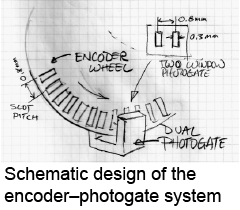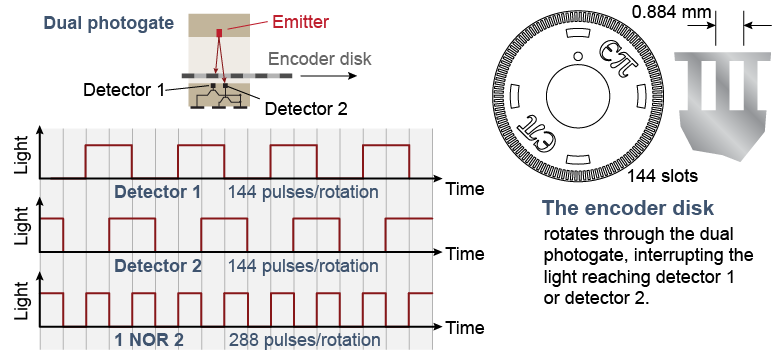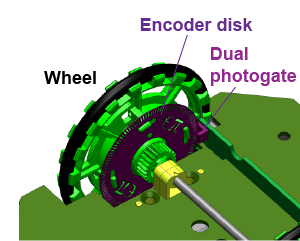|
The design of the ErgoBot provides a good example of physics and engineering together. While there were many aspects to the design, let’s focus on how we measure and control motion in one and two dimensions. Two of our important design goals were to be able to determine how far the ErgoBot traveled to within 1 mm and be able to know its direction of motion to within 1°. 
|
 The design concept was to use optical sensors (photogates) that turn on and off when a light beam is blocked. Optical sensors add no friction to the wheels. Attached to each wheel is an encoder disk that has many small slots. The slots interrupt the light beams in a tiny dual photogate. We needed the two detectors in a dual photogate to tell direction.
The design concept was to use optical sensors (photogates) that turn on and off when a light beam is blocked. Optical sensors add no friction to the wheels. Attached to each wheel is an encoder disk that has many small slots. The slots interrupt the light beams in a tiny dual photogate. We needed the two detectors in a dual photogate to tell direction. 
|

|
The photogate sensor has two windows that are 0.3 mm wide and separated by 0.8 mm. The encoder disk works by blocking one light beam while simultaneously leaving the other open. Based on the angles of the light beams as they travel through the slots to the sensor, each slot opening has to be 0.442 mm wide with a 0.442 mm separation between slots. The largest diameter disk that fits the wheel is 42.8 mm; the disk contains slots arranged on a 40.5 mm diameter circle, resulting in 144 slots around the disk. In one full revolution of the wheel, the disk produces 144 light pulses from each detector. 
|
 The two detectors are spaced apart by half the slot width such that one “sees” light when the other is dark. This gives us the direction of rotation and also allows us to get 288 pulses per rotation by combining both detector signals in a logical NOR function. By counting “edges” when a pulse starts or stops, we double the resolution to 576 counts per rotation. The wheel circumference is 201 mm, making our spatial resolution (201 mm) ÷ (576 pulses) = 0.349 mm/pulse.
The two detectors are spaced apart by half the slot width such that one “sees” light when the other is dark. This gives us the direction of rotation and also allows us to get 288 pulses per rotation by combining both detector signals in a logical NOR function. By counting “edges” when a pulse starts or stops, we double the resolution to 576 counts per rotation. The wheel circumference is 201 mm, making our spatial resolution (201 mm) ÷ (576 pulses) = 0.349 mm/pulse. 
 |
Logical or Boolean operators output true or false values based on the value of the two inputs, which each can be either true or false. The Boolean statement “a AND b” is true only if a and b are both true; otherwise, the output is false. The Boolean statement “a OR b” is true if either a, b, or both and and b are true; if both a and b are false, however, the output is false. The NOR operator is the negative or opposite of the OR operator. The logical statement “a NOR b” will be true if both a and b are false; otherwise, it will be false. 
|

